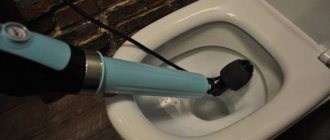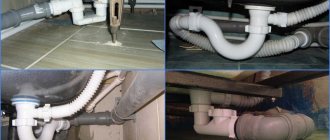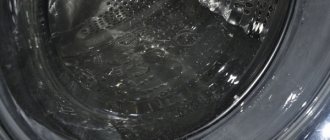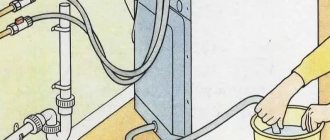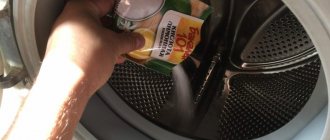Published: March 30, 2020
The washing machine fills the tank gradually, but quite quickly. If you notice that it takes a very long time to fill, it means that water is not flowing well into the washing machine. Sometimes the washing machine makes several attempts to start the program, but fails and gives a typing error.
Let's figure out what slows down the flood of water and prevents the SMA from washing normally. Most often, the culprits are external circumstances, not a breakdown.
Why is the water supply slow?
This question cannot be answered unambiguously, since the malfunction is influenced by several factors:
- Insufficient water pressure. Machines from any manufacturer (Samsung, LG or Indesit) do not draw water well if there are interruptions in the water supply line.
- The filter is clogged. A common reason why a Samsung washing machine does not draw water well is a clogged filter mesh in the inlet valve.
- Lack of cold water.
- The faucet that does not supply water well to the washing machine is half closed.
- Module failure. An LG washing machine does not draw water well, often due to a breakdown of the “brain” of the technical device. In this case, only a specialist can handle the repair.
- Damage to the water level sensor.
- Heating element malfunction.
Solenoid valve for water
Prohibited actions
If the machine does not fill with water, turn off the supply tap immediately. Leaving it open is strictly prohibited. It happens that users open the tap and then leave the machine unattended. If suddenly the water starts to flood again , this risks flooding the neighbors below.
If the user notices that water is not flowing into the washing machine, there is no need to fill the tank manually in the hope that the wash will go smoothly. Most likely, there was also a problem with the wash cycle, so there is no point in manually filling the drum.
It is also not recommended to:
- Repair the board at home.
- Repair the pressure switch. In modern washing machines this element is disposable. It does not need to be repaired, but replaced.
- Disassemble the mechanism yourself if the user is not sure that he can assemble it.
- Try to fill in water if the hatch is slightly open. Until the locking fault is resolved, washing cannot be started in any case.
When installing and connecting the machine yourself, you should not connect the hose more than half a meter from the floor. In such a situation, the water will drain itself without reaching the drum.
Why might water not be collected at all?
Washing machines Indesit, Samsung or LG may not only draw water poorly, but may not collect water at all for washing. What is the reason?
- The tap that supplies water to the drum is completely closed.
- Lack of water.
- The door is not closed properly, the lock is faulty.
- The pressure switch is broken.
- The valve supplying liquid to the washing machine is broken.
- Device connection is incorrect.
- Violation of operating rules.
Water supply to the drum
Failure in the control module
In electronic washing machines, the control module may malfunction. The appliance does not start the washing program and water does not flow into the drum. This problem is encountered after several years of using automatic washing machines, especially if the operating rules described in the manual are not followed.
You can solve the problem by manually flashing the module. Set all programs to zero and turn on the machine. If it blinks, the program has been reset and you can continue to use the device.
This action may not be enough if, for example, some cable or wire in the electronic module has burned out. Then it should be completely replaced, but without a specialist you will not be able to fix the breakdown.
If all of the above steps are completed and nothing helps, then most likely the washing machine has more serious damage. The drum may be faulty, the pressure switch may be broken, the pump or measuring instruments may be faulty. The machine, of course, will not draw water. Without a specialist, it will be difficult for you to understand the intricacies of the device. Only a qualified specialist can diagnose, identify and repair a washing machine.
How can I improve the situation?
Before calling a workshop or attempting to repair the device yourself, you need to perform basic steps to find the exact cause of the washing machine malfunction and how to fix it. The first thing to check is how tightly the hatch is closed and whether the lock works. If the door is not closed properly, the machine does not turn on automatically - this is how it is protected from unforeseen circumstances, for example, from a flood.
Water supply hose
If the hatch is fine, the problem may be the water pressure on the line. Call the utility company and find out what the problem is and how soon it will be resolved. Slow water pressure in this case will not harm the operation of the washing machine, but the washing process itself will be delayed.
Also, sometimes the tap supplying water to the washing machine is faulty, or it is not fully open.
The lock of the laundry loading hatch is broken or not closed
One of the main protections for new generation washing machines is the lock on the door hatch. If it does not fit tightly or closes without a characteristic click, water will not be poured into the unit and the washing program will not start. Make sure the door is tightly closed. To do this, open and close it again. Start the washing program again.
In some cases, the door may not lock, and the corresponding error icon will light up on the electronic display. This means that your lock is broken: the problem is in the locking tongue or latch located inside the body of the machine itself. Open it and look carefully: perhaps the rod that serves as a fastener for the latch has fallen out of the tongue on the door. It can be inserted by carefully disassembling the hatch. A mechanically broken lock and damaged door will need replacement.
If the door is not closed tightly, the machine will not draw water.
With frequent and long-term use, the hinges in the washing machine hatch that connect it to the washing machine body may become loose. This will cause the door to latch tightly. You can screw the hinges with your own hands using a screwdriver.
DIY repair
Depending on the problem, repairs may vary. Some problems can be fixed with your own hands, while others can only be dealt with by professionals. DIY repair methods:
- If there is water on the line, but the pressure is very weak, you can simply continue washing, but regardless of the program, the washing process will take a little longer. If this option does not suit you, then you need to call the utility company and find out why the dialing has been reduced and the time frame for restoring problems on the line.
- The water supply to the washing machine can be turned off using a special tap. If it is not fully open, water will be drawn in, but very slowly. The fix is easy. If the valve is open completely, but it is clear that this is the reason, the valve itself may break down, then it will have to be replaced.
- Sometimes water does not flow well into the washing machine because the inlet hose is kinked. It is necessary to check for this problem and straighten the hose.
- At the entrance to the washing machine, where the valve is installed, there is a special filter. At times it becomes clogged, and then the liquid flows into the washing machine is weak. If you clean it, the problem will disappear.
DIY machine repair
In the case when the inlet valve or electronic module is broken, it is better not to fix the problem yourself, but to contact a specialist. Fixing the problem yourself can lead to a complete malfunction.
Wiring faults
To understand why the washing machine does not add water, it is recommended to check the wiring and conduct a thorough diagnosis of the mechanism. Sometimes malfunctions in the operation of the device are caused by damage or loosening of the contacts of the wires connecting the internal elements of the case. It is better to entrust the wiring check to specialists.
To diagnose, technicians use a multimeter that measures current strength. If the indicators are underestimated, then the terminals should be tightened. Sections of wires may be damaged. They must be wrapped with electrical tape to prevent short circuits. If the wires are in disrepair, they cannot be repaired. It is necessary to carry out new wiring to extend the service life of the equipment.
The information provided will help you understand why there is little or slow water flowing into your washing machine. If you want your equipment to serve for a long time, do not repair it yourself; contact a service center.
Source
The filter mesh is clogged
A common factor that influences the machine not drawing water or doing it very slowly is a clogged filter mesh. It is located in front of the inlet valve and is designed to protect the unit from small debris that may enter from the water supply. But, since the quality of water often leaves much to be desired, this mesh can become clogged and prevent liquid from passing through. Or the pressure will become very weak.
What to do?
You can call a technician to clean the filter mesh, or you can try to deal with the problem yourself. To do this, you need to turn off the valve and disconnect the hose at the place where it connects to the washing machine. Then clean the mesh from any accumulated dirt and rust. After this, rinse the hose itself under high pressure.
Possible faults requiring repair
If your case is not similar to one described above, most likely your Samsung is faulty. According to the experience of RemBytTech specialists, most often the following breakdowns are typical for washing machines of this brand.
Faulty water supply valve - from RUB 1,800.
The valve is a housing with a membrane, the position of which is regulated by an electromagnetic coil. When voltage is applied to the coil, the membrane opens and the Samsung machine pours water. It is the coil in the fill valve that most often burns out. As a result, the membrane does not open and Samsung cannot draw water.
Valve malfunction is the most common reason why water does not flow into a Samsung washing machine.
Signs
Samsung washing machine does not fill with water. Error 4E may appear on the display.
How to fix
The water supply valve must be replaced with a new one.
Faulty UBL - from 1600 rubles.
Probably, the thermal tablet has worn out and does not work, or the bimetallic plate has lost its flexibility. Therefore, the lock does not work and the door does not lock.
Signs
Samsung does not block the door, water does not start pouring. On models equipped with a display, the code may appear.
How to fix
UBL cannot be repaired; the unit needs to be replaced.
The control module has failed - from 2400 rubles.
The control board “manages” the operation of the washing machine. Often it breaks down due to power surges or moisture ingress: individual radio elements fail or the tracks oxidize and rot. Most often, with this breakdown, it occurs in the UBL or fill valve circuit.
Signs
Samsung washing machine does not fill with water. Codes or may appear on the screen.
How to fix
The control unit is being diagnosed. According to its results, the master:
- replaces burned-out radioelements;
- solders faulty tracks/contacts;
- replaces the entire board when the processor fails or is extensively damaged.
Faulty water level sensor (pressure switch) - from RUB 1,900.
Normally, the unit determines the amount of water in the tank. If it is stuck in the “full tank” position, the washer considers that there is enough water and does not start filling the water.
A malfunction of the pressure switch may be due to contamination of the pressure sampling chamber, a blockage in the level sensor hose, or a breakdown of the sensor itself.
Signs
Samsung washing machine does not fill with water. A code may appear on the display.
How to fix
The technician diagnoses the pressure switch and, based on the nature of the problem:
- cleans the pressure sampling chamber;
- blows out the unit hose;
- if the sensor malfunctions, replace the entire pressure switch assembly.
Open circuit between the control board and the water supply valve - from 1800 rubles.
Due to a faulty wiring or contacts, the control board “does not see” the valve: it does not respond to commands. Most often, a break in the circuits is associated with vibrations during operation of the machine. In private homes, the reason may be damage to wires by rodents.
Signs
The machine does not take in water. Samsung devices with a display can show code 4E.
How to fix
The technician diagnoses the Samsung by ringing the circuit. When the signal break point is found, it:
- solders faulty contacts or changes the entire contact group;
- restores wiring by twisting or changes the entire cable.
The wiring and/or contacts between the control unit and the UBL are faulty - from RUB 1,800.
There is a break in the circuit, and the hatch lock does not respond to commands from the unit. Breaks most often occur due to vibrations: wires fray, contacts become loose. In private homes, wiring is often chewed by mice and rats.
Signs
The washing machine does not block the loading hatch. Water does not enter the tank. Models with a display indicate a problem with a code.
Water supply hose problem
If this does not help, check the hose to see if it is broken or if there is something heavy on it that could impede the flow of fluid. Another factor affecting the set is a clogged hose. In this case, liquid can flow into the unit, but very slowly and with little pressure.
What to do?
If there is anything on the hose, remove it. It may be damaged, then you will have to replace it with a new one. If clogged, you need to disconnect it from your unit and rinse it well under strong pressure.
Troubleshooting yourself:
The situation in which the “washing machine” slowly draws water can be twofold.
The reasons may be a breakdown, an unfortunate combination of circumstances or simple carelessness. So, the main situations in which you can solve the problem yourself:
- The water supply has low water pressure. You can check the pressure visually by opening the cold water tap all the way. If the water barely flows from the tap, rejoice, the problem has been found.
In this case, there are only 2 options:
- continue washing, not paying attention to the low pressure, but you should be patient, because the machine will take a long time to wash;
- wait until the water pressure in the tap becomes normal. During this time, you can dial the telephone number of utility services and reliably find out about the causes of low pressure and the time to fix the problem.
Electronics problem
Shut-off valve is not fully open. With the help of such a valve, the water supply to the washing machine is closed or opened. If a valve is detected that is not completely open, the problem can be solved with one movement of the hand - simply open the valve all the way. It may happen that the crane itself has suffered physical wear and tear. The faucet may stall or begin to rotate. In such a situation, you must independently replace the old faucet with a new one or call a plumber.- There is a kink in the inlet hose. When you have checked the water pressure and found no problems, you need to inspect the supply hose; a kink may form: it is likely that the reason for the poor flow of water into the “washing machine” was a kink in the hose. It's easy to fix the problem - just straighten the hose and the water flow will resume.
- The fill valve strainer, which is installed at the inlet of the washing machine, is clogged. In the place where the inlet hose is connected to the washing machine, a filter mesh is installed, which allows all the water entering the washing machine to pass through it. Over time, the filter may become clogged and have poor water flow, since tap water contains various impurities and small particles. You can fix this like this:
- shut off the water supply;
- unscrew the inlet hose;
- Using pliers, very carefully pull the mesh out of the inlet valve;
- then clean it with a stiff brush and rinse under strong water pressure.
In the case where the above tips did not bring the expected success, and your washing machine still slowly draws water, then the most likely reason may be a breakdown.
The table shows possible problems and their resolution:
| Breaking | Repair or replacement | Cost of services (spare parts + repairs) |
| Intake valve failure | Due to a malfunction, the electronic valve that regulates the flow of water into the washing machine cannot open completely, and the “washing machine” simply “physically” does not have the ability to draw the required amount of water. |
In this case, the valve must be replaced with a new one.
The table shows the approximate cost taking into account the work of the technician and the cost of spare parts. A specialist will set a more accurate price for repairs after diagnosing your washing appliance, taking into account the complexity of the breakdown, and necessarily the manufacturer and model of the appliance.
Trust washing machine repairs to professionals and with a guarantee.
If, when washing clothes, you find that water is slowly pouring into the machine, and you cannot fix the problem yourself, contact the service center
Never forget that operating a device with small faults can cause a major breakdown, which will require you to costly repairs, or it may happen that the device cannot be repaired at all. Therefore, it is better to follow the old Russian proverb: “Don’t put off until tomorrow what you can do today!”
Call right now and our technicians will definitely come to the rescue of your washing machine!
Source
Failure of the water supply valve
The intake valve is activated when it receives a signal from the control module. But in some cases the valve breaks; there may be several factors for this: a clogged filter, or a burnt-out winding coil. Then the machine completely stops drawing liquid. To find out if the valve is the cause of this, you need to remove it and connect it to the inlet hose. Then apply current to each coil and check the valve: if it opens, then this is not the problem, it is working properly. If it doesn’t open, then it’s out of order. Another option is that the valve opens and closes after turning off the power, but it is not tight enough, and you will see that liquid continues to leak. This occurs due to weakening of the elasticity of the diaphragm or rod springs.
What to do?
If the cause of valve failure is contamination of the mesh, then you need to clean it. If the coil burns out, then it is enough to replace it. You can check the performance of the coil by measuring the resistance. It should be within 2-4 kOhm. If the valve leaks, it must be replaced. But it is better to entrust this matter to experienced craftsmen.
Reasons why the unit does not take in water
There may be several reasons for this malfunction, the most obvious among them:
- Lack of water in the water supply is the most common reason. It's easy to check - you just need to open any tap. Maybe the water pressure is insufficient - this can also be seen visually by opening the tap in the washbasin. It also happens that the valve through which water flows into the inlet hose is accidentally closed.
- Clogged inlet line. Most likely, the inlet strainer is clogged due to poor quality tap water. It is less likely that the inlet hose is clogged, but such cases also happen.
Washing machine inlet hose
The listed reasons are easily detected and eliminated independently. The inlet hose is disconnected from the SMA, then the mesh filter is carefully removed from the inlet hole in the machine. If there is a blockage, the mesh is cleaned and washed under a strong stream of water.
The mesh filter is removed with pliers
The inlet hose should also be inspected for damage and rinsed under a strong stream of water.
In addition to the simplest reasons for the lack of water supply to the unit, there are others.
Hatch door malfunctions
The hatch of each washing machine has a locking device (hereinafter also referred to as UBL, lock), which locks the door as soon as the washing program starts. This occurs in order to prevent the door from opening and liquid leaking from the drum. The hatch is closed throughout the entire duration of the program.
Washing machine hatch door
When the door closes, you should hear a click as the door tongue engages the latch inside the frame. If this does not happen, it means the door is not closed completely. In this case, the signal to close the hatch is not sent to the control unit, and water does not enter the drum of the washing machine. There may be several reasons why the door does not slam shut:
- the hatch hinges are loose, so the tongue cannot get into the latch;
- the door tongue is damaged or dislodged;
- rubber gasket is deformed;
- The plastic guide is damaged.
If the door latches normally, but a second click is not heard, indicating blocking, it means that the UBL has failed or the control unit board is faulty.
The most common mechanical defect is misalignment of door hinges as a result of prolonged exposure to vibration. The “fix” is simple - you need to tighten the hinge fasteners with a screwdriver or replace them with new ones.
The most common electrical fault is a lock failure. What to do in this case? You can replace the UBL yourself; the lock is relatively inexpensive. To do this you need to do the following:
- Open the hatch door.
- Remove the elastic cuff sealing the drum. To do this, pry it up with a screwdriver and remove the clamp that holds it.
- Unscrew the screws holding the lock.
- We take out the UBL through the hole between the cuff and the body.
- Disconnect the connector and connect it to the new device.
- We install the new device in place.
Sequence of actions when replacing UBL
The whole job takes just a few minutes. After this, you can turn on the SMA and make sure that it pumps water into the tank.
A visual demonstration of replacing the locking device in a Beko washing machine in the following video:
Inlet valve failure
This defect is one of the main reasons why the washing machine does not fill with water. This part controls the supply of water to the tank. The operation of the valve is regulated by an electronic control unit (hereinafter also referred to as the ECU), which sends signals about the opening and closing of the valve.
Washing machine inlet valve
The main elements of the part are electromagnetic coils that unlock and lock the valves for the flow of water. In most modern models, the valves have two control coils that distribute the flow of water to sections that are filled with detergent.
You can diagnose and replace the part yourself. To do this, turn off the power to the washing machine, then open the top cover, disconnect all the pipes from the valve, unscrew the fasteners and bend the latches, if any. Remove the valve from its seat.
Removing the fill valve from the machine body
It is easy to check the integrity of the coils - when checking with a multimeter, their resistance should be in the range of 2–4 kOhm. In the event of a break or short circuit, the part must be replaced. A new valve is relatively inexpensive.
Pressostat defect
This part is a pressure sensor that determines the water level in the tank. The pressure switch can be found on one of the panels if you remove the top cover of the SMA housing. As a rule, the part has a round shape and a pipe from the tank is connected to it.
Pressostat in the washing machine
The pipe connected to the sensor transmits the air pressure in the tank to its membrane. As water fills the tank, pressure increases as air is forced out. As soon as the pressure reaches the desired level, the pressure switch gives a signal to the electronic control unit and it stops the water supply.
To check and replace the part, you need to disconnect the pipe by loosening or removing the clamp, then check it for blockages, kinks and damage. If everything is in order with the pipe, connect a piece of another hose of the same diameter to the sensor and blow into it. When a working pressure switch is activated, characteristic clicks should be heard. If this does not happen, you will have to replace the part by first removing the fasteners.
Control unit malfunction
If the SM does not take in water and does not wash, the fault may be with the ECU. For example, its electronic board may not give a signal to turn on the inlet valve. It happens that the ECU gets stuck. Then you need to remove the plug from the socket and wait about half an hour. If turning it on again does not correct the situation, you will have to call a technician to diagnose the problem.
ECU - a device that controls the operation of the washing machine
In most cases, malfunctions associated with the water supply to the SMA can be eliminated independently. According to statistics, a simple lack of water and blockages are most often the cause of this phenomenon.
Problem with the pressure switch
The pressure switch, also known as a water level sensor, is responsible for the amount of liquid collected in the tank. If the pressure switch is broken and does not evaluate, then it does not arrive and the washing machine does not start the wash cycle. To make sure that the sensor is broken, you need to check it. To do this, you need to remove it, and then disconnect the hose and contacts. After this, it is advisable to clean the contacts and rinse the hose.
Now check the sensor: take a second hose of the same diameter as the one you disconnected. Attach it to the inlet fitting and blow into it. At this time, place the pressure switch to your ear and listen: the presence of clicks will indicate the serviceability of the sensor, their absence will indicate a breakdown.
What to do?
If the problem is in the pressure switch, then it needs to be replaced. To do this, you need to call a technician or contact a service center.
Breakdown of the pressure switch
The reason for underfilling of water may be a breakdown of the pressure switch - a water level sensor that sends false readings to the control module. The malfunction of the device is caused by the formation of blockages. As a result, it is necessary to check problem points in the device itself for the possibility of accumulation of scale, dirt, powder particles, grease, plaque, and foreign objects.
It is recommended to inspect the tube connecting the sensor to the pressure tank. If during the inspection it turns out that the pipe is clogged, you need to clean it. The technician will give you accurate information on the operating status of the sensor.
Heating element malfunction
If the heating element responsible for heating the water breaks down, the washing machine stops drawing water, and many other functions stop working. In this case, the rinse mode should work, because it does not require heating. If the problem really is a breakdown of the heating element, then you will notice this by other signs: after washing, the laundry remains dirty and has an unpleasant odor, the door remains cold.
What to do?
To solve the problem, you need to replace the heating element.
Call the master
In situations where there is no opportunity or time to repair a washing machine, you can call a technician from a household appliance repair company. Contact information for such companies can be found on the Internet.
It is advisable to give preference to companies that have been working in the service market for years and have a reliable reputation. This circumstance will allow you to protect yourself from scammers and bad craftsmen.
The cost of the work depends on the complexity, time spent by the master, and the pricing policy of the company itself. Even within the same city, price lists of companies can have significant differences.
The average cost of work in Moscow is:
- diagnostics and repair/replacement of the control unit – from 2,000 rubles;
- replacement of the hatch locking device – from RUB 1,500;
- replacement of the pressure switch – from 1,400 rubles;
- replacement of water supply valve – from RUB 1,200.
The price of new parts is not included in the cost of work.
Control module problem
The most difficult problem, which is unlikely to be solved on your own unless you have special skills and knowledge, is a breakdown of the control module. It is from there that commands come, including to the intake valve. Contacts in any section of the module may burn out. Reasons for this phenomenon:
- ingress of liquid or detergents into the contact system;
- short circuit in external networks;
- too much load on the contacts of the heating elements.
If this failure occurs, the control module will most likely need to be replaced.
What to do?
The easiest way is to entrust the repair to professionals. In the meantime, remember the old way of washing - by hand. If you are not going to give up, then you can try cleaning the contacts of the control module. To do this, you will need a special liquid that needs to be injected into the section where there are burnt contacts. If the deposit is small, then this simple action can be quite effective.
The water supply system is not working
Check to see if the water supply valve is open; it may be located in the plumbing cabinet or on the water supply pipe. Make sure that the water supply hose is not broken, pinched or crushed anywhere. To do this, you need to close the water supply tap to the device, disconnect the water intake hose from the washing machine and lower it into a bathtub or other container, then open the water. If the pressure is weak, turn off the water, carefully remove the cleaning mesh with pliers, rinse it and install it back.
You should also check the hose itself for possible blockages. If water flows through the hose at normal pressure, the problem may be in the inlet valve.
Why is my washing machine not drawing water well?
There is also a situation when the washing machine takes in water, but slowly and in insufficient quantities . Why does this happen and what to do in such a situation? There can be many reasons for this, and they are the same ones because of which she does not gain anything at all. Here is a short list of them:
- Weak pressure in the tap. If this is true, then the machine will not type well. Then just wait until the situation changes and you can wash as usual. Or you will have to come to terms with the fact that the washing process will take a long time.
- The valve is not fully open. Check it and correct it if necessary.
- The filter mesh is clogged. This reason and the way to eliminate it were described above. But even if the machine generates weak pressure, it is better to eliminate this malfunction as quickly as possible. Otherwise, the filter will become completely clogged and the washing machine will stop working altogether.
- Problems with the hose - it may be broken, crushed by a heavy object, or clogged.
- Intake valve malfunction. It may need to be replaced.
If you find that your washing machine does not fill with water or does not fill well, follow this algorithm of actions.
First of all, check its presence in the tap and the inlet valve. If everything is in order, disconnect the hose, clean it and the filter mesh. Reinstall everything and try running the wash cycle again.
Check the parts responsible for drawing water
The quality of washed laundry depends not only on the powder and additional detergents, but also on a certain volume of liquid supplied to the drum. If the unit takes in little water, this can make it difficult to wash, rinse clothes, and also lead to a malfunction of the thermostat. To avoid problems, do the following:
Pressure in the pipeline
Open the cold water tap. If the pressure is weak, then there is no serious problem. You can:
- do not attach importance to low pressure, it will only increase the duration of the wash;
- stop washing and wait until the pressure is restored.
Correct connection of the machine with communications
You should observe the machine as it drains. If you hear the murmur of liquid in the pipes during the spin cycle, most likely the connection was made incorrectly. The unit must be reconnected to the communication systems. In this case, it is better to call a specialist who will quickly and competently approach the solution to the problem.
Turn the valve all the way
A shut-off valve that is not fully open may cause water to stop flowing. Therefore, you need to pay attention to this and bring the valve into working condition. It happens that this part scrolls idle or does not budge. The valve needs to be replaced here. If it is difficult to install it yourself, you lack skills and professionalism, you need to call a plumber.
Check the condition of the inlet hose
If reasons related to poor pressure, operation of the inlet valve, or connection to communications are excluded, then you need to check the inlet hose. It may be bent in several places, making it difficult for water to enter the drum. Straighten the hose, after which the amount of water should increase.
For free flow of water, the hose must be at a level of 50 cm from the floor. If this condition cannot be met, then the craftsmen advise connecting the drain through a check valve.
Clean the mesh filter
At the junction of the inlet hose to the washing machine, a filter mesh is inserted, through which water enters the device. After repeated use of the unit, impurities contained in the liquid get onto the filter. Therefore, the mesh has difficulty functioning. The filter needs to be cleared of any blockages.
Why is the washing machine taking on water slowly?
It is quite easy to discover that the washing machine takes a long time to fill with water - quite a long time passes, and the wash still does not start. In this case, you will have to check everything, from external elements to the internal parts of the device. If the washing machine slowly draws water immediately after connection and installation, you should check the water supply. The pressure may not be strong enough and therefore filling the device to the required level may take a long time. You should also check the faucet in case it is not open enough or is broken.
If this is not the problem, then the malfunction may occur for the following reasons:
- the inlet filter is clogged;
- the intake valve has broken down;
- the water level sensor has failed;
- the programmer is broken;
How to determine that the machine cannot fill with water
When the laundry in the drum is dry, the SM hums and does not spin the drum, the breakdown is clearly visible. But there are situations when there is water in the drum, but the wash does not start and it is not clear what happened. It may also be that the water flows too slowly and the machine identifies this as a breakdown. In this case, a fault code appears on the display. SMAs without a display indicate a breakdown by flashing indicators.
Electrolux machine with code E10 reports that water is not entering the tank
For example, if the Indesit washing machine does not draw water, the combination H20 appears on its display. The same code is displayed in SM Ariston and Hotpoint Ariston. Electrolux and Zanussi units display message E10 or E11. The following information appears on the displays of washing machines of other brands:
- Samsung – E1;
- LG – PE or IE;
- Bosch – F01 or Aquastop;
- Whirlpool – FH or F1;
- Candy – E02;
- Asko – E01 or Water inlet fault.
If there is no display, the malfunction can be recognized by a combination of flashing indicators (each brand of SM has its own, you can find it in the instructions for use).
How to troubleshoot a problem
If the washing machine slowly draws water, then you should start checking with the inlet filter. First, you should remove it and inspect it for rust or plaque. After this, you just need to carefully rinse the filter under running water from the sink, removing all existing blockages. If it was the problem, then after installing it back, water will flow at normal speed.
The next check point will be the valves. Here the problems can be much more diverse, and it will take time to check them. Often the cause of slow water intake is the mesh on the valves, which becomes clogged over time, or a burnt-out winding. If a blockage occurs, it can be simply removed by cleaning the mesh. Regular annual cleaning of the screens in all valves will help avoid this problem. And a burnt-out winding can be replaced with the same one from another valve, since they are most often interchangeable.
Another reason why the washing machine is slow to fill with water may be failure of the electronics. Often the water level sensor and programmer break down. They are responsible for the correct execution of the user's program. It is quite difficult to independently check their performance, since they are not only located quite inconveniently for dismantling, but also their inspection requires special knowledge. Attempts to fix such a malfunction yourself may cause new breakdowns due to negligence. If there is a suspicion that the electronics in the washing machine have broken down, it would be safer to turn to specialists for help.
Blockage in the pump
It is possible that the cause of poor water supply in the washing machine is a dirty pump. Debris from the water pipe, small items from clothing, and remnants of detergents that did not dissolve during washing can get into it. If the drain path in the SMA has never been cleaned, then over time dirt accumulates in the pump.
To disassemble the pump and remove blockages, you must prepare:
- open-end wrench;
- flathead and Phillips screwdrivers.
You must first select a container for the drained liquid while cleaning the pump. Before disassembling, you need to drain the remaining water and clean the filter. Stages of work:
- Unplug the machine.
- Press out the latches of the hatch cover located on the front panel.
- Remove the filter.
- Place the container and drain the liquid into it, clean the filter.
To clean the pump, you need to disassemble it. The body of the part consists of two parts - the volute and the pump itself with an impeller. It is necessary to inspect the impeller, since it is on it that hair and threads collect, complicating the functionality of the unit. The snail should also be inspected to remove debris. After this, the entire structure needs to be reassembled and the program launched. You should listen to the machine, the noise it makes, and monitor how well the water is being pumped out.
If, after cleaning the pump, underfilling is again observed, then the pump needs to be replaced. On this issue, it is better to contact a washing machine repair service.
Filter or inlet valve malfunction
Another possible cause of malfunction is that the filter may be so clogged that it does not allow water to pass through. In this case, we turn off the water supply and remove the inlet hose. At the point where our hose connects to the washing machine. The intake valve filter is located at this location. It looks like a fine mesh. If this mesh is clogged, it must be cleaned and washed. And if everything is fine with her, then we will continue to look for the cause of the poor water supply.
The most unpleasant thing, perhaps, will be a breakdown of the control module. In this case, you cannot do without special skills. Independent repair or replacement of the module is not recommended for persons who do not have special knowledge and skills. Therefore, in this case it is necessary to contact specialists. The module is one of the most expensive parts of a washing machine. Most home appliance repair services prefer not to repair the module, but to replace it. Such repairs can be quite expensive. But often, it’s still cheaper than buying a new car.
Causes of failure
The first reason will be the lack of cold water or weak pressure. If the whole point is low pressure, then the water will pour in very slowly. Because of this, the process of washing clothes can last for hours. Try turning on the cold water in the mixer to full and check the intensity of the flow. If it is very weak or water does not flow at all, then we have found our problem. Of course, we cannot solve it directly. After all, we do not control the water supply to the house. There are two options to get out of this situation:
- Just wait for the water to appear. It happens that during various repairs the water is turned off.
- Call the housing office and ask them about the causes of the malfunction and the time frame for their elimination. There is also a possibility that the housing office does not know that there are problems with the water supply in your house. Therefore, just in case, it is better to call. This will increase the chances that the water supply will again please you with normal operation in a short time.
